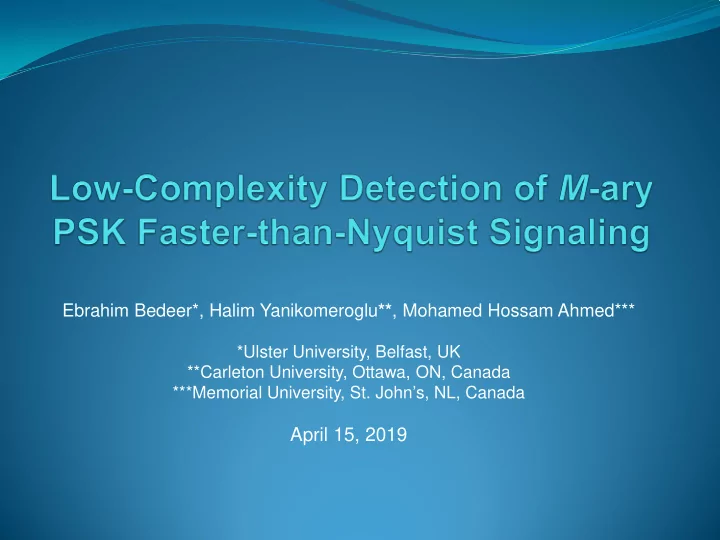

Ebrahim Bedeer*, Halim Yanikomeroglu ** , Mohamed Hossam Ahmed*** *Ulster University, Belfast, UK **Carleton University, Ottawa, ON, Canada ***Memorial University, St. John’s, NL, Canada April 15, 2019
Agenda Introduction FTN Signaling System Model Our FTN Signaling Contributions Quasi-Optimal Detection (High SE) Symbol-by-Symbol Detection (Low SE) M -ary QAM Detection M -ary PSK Detection Conclusions 2
Introduction Orthogonality is an advantage and a constraint. Nyquist limit is more of a guideline than a rule. Nyquist limit simplifies receive design by avoiding ISI. Faster-than-Nyquist (FTN signaling) intentionally introduce ISI to improve SE. Detection: Increased complexity 3
Introduction FTN signaling concept exists at least since 1968 [Saltzberg-68]. FTN signaling term coined by Mazo in 1975 [Mazo-75]. Mazo Limit: FTN does not affect minimum distance of uncoded sinc binary transmission up to a certain range. Mazo Limit: 1/0.802 25% faster than Nyquist 25% in spectral efficiency. Much faster Mazo limit: Possible, but with some SNR penalty. Saltzberg B. Intersymbol interference error bounds with application to ideal bandlimited signaling. IEEE Transactions on Information Theory. July 1968; 14(4):563-8. Mazo JE. Faster-than-Nyquist signaling. The Bell System Technical Journal. Oct. 1975; 54(8):1451-62. 4
FTN Signaling Basic Idea 5
FTN Signaling Basic Idea 6
Extension of Mazo Limit Other pulse shapes (root-raised cosine, Gaussian, …) Non-binary transmission Frequency domain 7
Our FTN Publications Ebrahim Bedeer, Halim Yanikomeroglu, and Mohamed H. Ahmed, “Quasi-optimal sequence estimation of binary faster-than-Nyquist signaling”, IEEE ICC 2017 , Paris, France. Ebrahim Bedeer, Mohamed H. Ahmed, and Halim Yanikomeroglu, “A very low complexity successive symbol-by-symbol sequence estimator for binary faster- than-Nyquist signaling”, IEEE Access , March 2017. Ebrahim Bedeer, Mohamed H. Ahmed, and Halim Yanikomeroglu, “Low- complexity detection of high-order QAM faster-than-Nyquist signaling”, IEEE Access , July 2017. Ebrahim Bedeer, Halim Yanikomeroglu, and Mohamed H. Ahmed, “Low- Complexity Detection of M -ary PSK Faster-than-Nyquist Signaling”, IEEE WCNC 2019 Workshops , Marrakech, Morocco. 8
FTN Block Diagram 9
Quasi-Optimal Detection (High SE) Ebrahim Bedeer, Halim Yanikomeroglu, and Mohamed H. Ahmed, “Quasi-optimal sequence estimation of binary faster-than-Nyquist signaling”, IEEE ICC 2017 , Paris, France. 10
Modified Sphere Decoding (MSD) Noise covariance matrix can be exploited to develop MSD. Estimated data symbols can be found using MSD as 11
Simulation Results 12
Simulation Results 13
Simulation Results Spectral Efficiency SE= log2(M) x [1/(1+ β)] x (1/ τ ) bits/s/Hz 14
Symbol-by-Symbol Detection (Low SE) Ebrahim Bedeer, Mohamed H. Ahmed, and Halim Yanikomeroglu, “A very low complexity successive symbol-by-symbol sequence estimator for binary faster- than-Nyquist signaling”, IEEE Access , March 2017. 15
Successive Symbol-by-Symbol Sequence Estimation (SSSSE) Received sample 16
Successive Symbol-by-Symbol Sequence Estimation (SSSSE) Received sample Perfect estimation condition for QPSK FTN signaling 17
Operating region of SSSSE 18
Successive Symbol-by-Symbol Sequence Estimation (SSSSE) Received sample Perfect estimation condition for QPSK FTN signaling Estimated symbol 19
Successive Symbol-by-Symbol with go-back- K Sequence Estimation (SSSgb K SE) Received sample Estimated symbol 20
Simulation Results 21
Simulation Results 22
M -ary PSK Detection Ebrahim Bedeer, Halim Yanikomeroglu, and Mohamed H. Ahmed, “Low- Complexity Detection of M -ary PSK Faster-than-Nyquist Signaling”, IEEE WCNC 2019 Workshops , Marrakech, Morocco. 23
FTN Detection Problem Received sample Received sampled signal in vector format Received sampled signal after (optional) whitening filter 24
FTN Detection Problem Received sampled signal Maximum likelihood detection problem NP-hard Can be solved in polynomial time complexity using ideas from semidefinite relaxation and Gaussian randomization 25
Proposed FTN Detection Scheme 26
Simulation Results Spectral Efficiency 8-PSK SE= log2(M) x [1/(1+ β)] x (1/ τ ) bits/s/Hz Roll-off factor: β = 0.3 Mazo limit: τ = 0.802 SE = 2.31 bits/s/Hz 17% increase in SE excellent 27
Simulation Results Roll-off factor: β = 0.5 Spectral Efficiency SE= log2(M) x [1/(1+ β)] x (1/ τ ) bits/s/Hz Performance vs complexity tradeoff Nyquist signaling 8-PSK QPSK QPSK, SE = 2 bits/s/Hz J. B. Anderson and A. Prlja, “Turbo equalization and an M-BCJR algorithm for strongly narrowband intersymbol interference,” ISIT 2010. 28
Simulation Results 29
Conclusions FTN signaling is promising to increase the SE. Tradeoff between performance and complexity. Gain of FTN increases at higher values of SE. Channel coding? AI / machine learning? 30
Recommend
More recommend